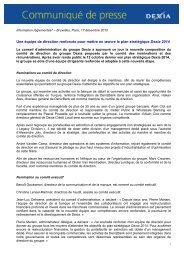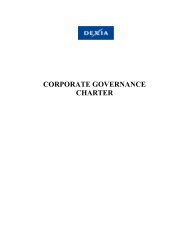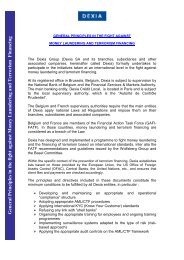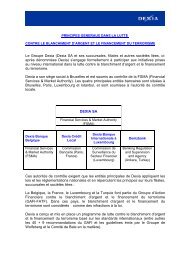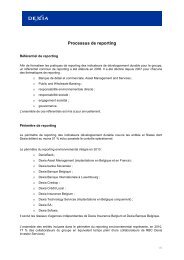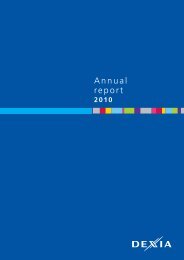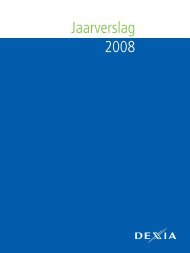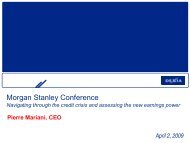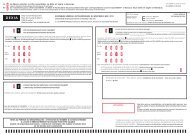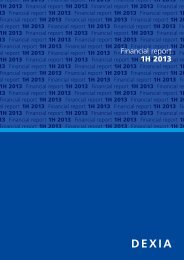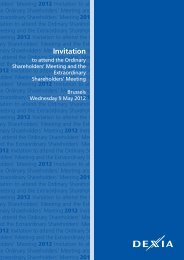Annual report 2009 - Dexia.com
Annual report 2009 - Dexia.com
Annual report 2009 - Dexia.com
- No tags were found...
Create successful ePaper yourself
Turn your PDF publications into a flip-book with our unique Google optimized e-Paper software.
Notes to the consolidated fi nancial statementsManagement <strong>report</strong>Consolidatedfinancial statements<strong>Annual</strong> financial statementsAdditional information• Credit risk is the risk of loss resulting from client or counterpartydefault or rating migrations and arises on creditexposure in all forms, including settlement risk;• Funding and liquidity risk is the risk of the entity beingunable to meet its payment when due, or being unableto borrow funds in the market on an unsecured, or evensecured basis at an acceptable price to fund actual or proposed<strong>com</strong>mitments.The notional amounts of certain types of derivative financialinstruments provide a basis for <strong>com</strong>parison with instrumentsrecognised on the balance sheet but do not necessarily indicatethe amounts of future cash flows involved or the currentfair value of the instruments and, therefore, do not indicate<strong>Dexia</strong>’s exposure to credit or price risks. The derivative instrumentsbe<strong>com</strong>e favourable (assets) or unfavourable (liabilities)as a result of fluctuations of the underlying interest, foreignexchange, equity or credit risks relative to their terms. Theaggregate contractual or notional amount of derivative financialinstruments on hand, the extent to which instrumentsare favourable or unfavourable and, thus the aggregate fairvalues of derivative financial assets and liabilities can fluctuatesignificantly.Assumptions and techniques have been developed to providea consistent measurement of fair value for <strong>Dexia</strong>’s assets andliabilities. However, because other institutions may use differentmethods and assumptions, fair value disclosures cannotnecessarily be <strong>com</strong>pared from one financial institutionto another.As the <strong>Dexia</strong> Transformation Plan is resulting in a new TFMsegmentation and a new Financial Markets Risk organisation,particular challenges were met in order to adapt our policies,guidelines and procedures to the new TFM and BSM organisationboth from a credit and market risk perspective.3.1. Fair value of financial instrumentsFair value is the amount for which an asset could beexchanged, or a liability settled, between knowledgeable,willing parties in an arm’s-length transaction. Quoted marketprices in an active market (such as a recognised stockexchange) are to be used as fair value, as they are the bestevidence of the fair value of a financial instrument. Quotedmarket prices are not, however, available for a significantnumber of financial assets and liabilities held or issued by<strong>Dexia</strong>.If a financial instrument is not traded on an active market,recourse is provided by valuation models. A valuationmodel reflects what the transaction price would have beenon the measurement date in an arm’s length exchangemotivated by normal business considerations, i.e. the pricethat would be received by the holder of the financial assetin an orderly transaction that is not a forced liquidation orforced sale.The valuation model should take into account all factors thatmarket participants would consider when pricing the asset.Measuring the fair value of a financial instrument requiresconsideration of current market conditions. To the extentthat observable inputs are available, they should be incorporatedinto the model.<strong>Dexia</strong>’s approach to the valuation of its financial instruments(direct P/L, AFS and annex) can be summarised as follows:3.1.1. Financial instrument measured at fair value(trading, FVO, AFS, derivatives)Financial instruments measured at fair value forwhich reliable quoted market prices are available:If the market is active – meaning that bid-offer prices areavailable representing effective transactions concluded onan arm’s length basis between willing counterparties – thesemarket prices provide for the most reliable evidence of fairvalue and therefore shall be used for valuation purposes.The use of market prices quoted in an active market for identicalinstruments with no adjustments qualifies for inclusionin level 1 within IFRS 7 fair value hierarchy, contrary to theuse of quoted prices in inactive markets or the use of quotedspreads.Financial instruments measured at fair valuefor which no reliable quoted market prices areavailable and for which valuations are obtainedby means of valuation techniquesFinancial instruments for which no quoted market prices inactive markets are available are valued by means of valuationtechniques. The models that <strong>Dexia</strong> uses range from standardmarket models (discount models) to in-house developed valuationmodels.In order for a fair value to qualify for level 2 inclusion, onlyobservable market data should be used. The market data that<strong>Dexia</strong> incorporates in its valuation models are either directlyobservable data (prices), indirectly observable data (spreads)or own assumptions about unobservable market data. Fairvalue measurements that rely significantly on own assumptionsqualify for level 3 disclosure.• For bonds for which no liquid market exists, these are valuedusing <strong>Dexia</strong>’s Mark-to-Model approach. The valuationprice is <strong>com</strong>posed of a market price <strong>com</strong>ponent and a modelprice <strong>com</strong>ponent. The weight granted to the model price<strong>com</strong>ponent reflects an assessment of the illiquidity of themarket considering the bond characteristics.For its Mark-to-Model price, <strong>Dexia</strong> uses a discount cash-flowmodel, based on a discounted spread that incorporates bothcredit and liquidity risk. The credit spread is estimated fromthe security specific characteristics (sector, rating, Loss GivenDefault) and from the level of some liquid CDS indices. Aliquidity <strong>com</strong>ponent is added to the credit <strong>com</strong>ponent toobtain the instrument’s spread. The weight of the liquidity<strong>com</strong>ponent depends on the instrument’s central bank eligibilitycharacter.Due to the financial crisis of 2008, many assets and liabilitiesfor which quoted prices were available becameilliquid. Risk Management developed models in 2008 tovalue those illiquid financial instruments. Risk managementadjusted its classification between fair value levels in <strong>2009</strong>based on the re<strong>com</strong>mendations included in the amendmentto IFRS 7 published in March <strong>2009</strong> and included inthe Exposure Draft on Fair Value, published in May <strong>2009</strong>.Regarding structured derivatives, Risk management continuesto implement the action plan validated by the ManagementBoard, including back-testing of models and external price<strong>com</strong>parisons, follow-up of evolutions of market parametersand liquidity together with Front and middle offices, Legaland Finance departments.120<strong>Dexia</strong> <strong>Annual</strong> <strong>report</strong> <strong>2009</strong>



